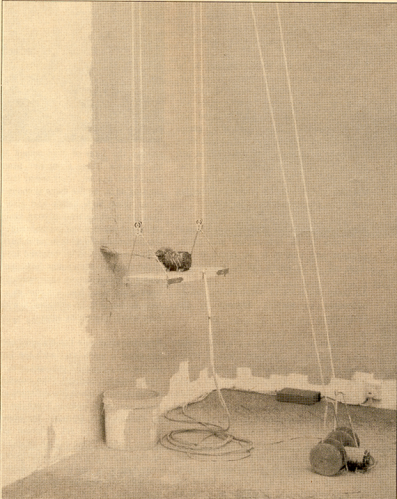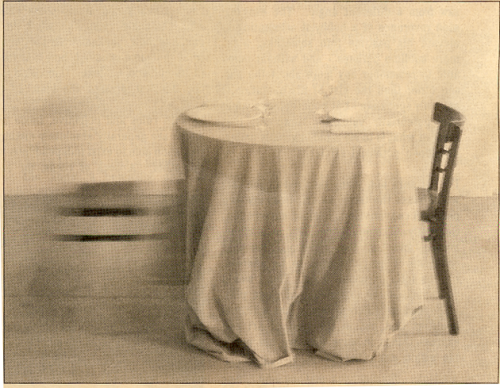Milo Garcia, i'M a Gorila c, i Micro Gala, i i a GlaM roc
Milo Garcia Makes Stupid Machines
The buzz around new technology seems to a great extent to be situated around notions of a new sublime; the internet, cyberspace, a new image based culture. The hyperbole relating to the way that information and images emerge and merge in this new space accords with a view of the world characterised by semiotic and American post-modern theory. During the 1980's a great deal of art work emerged from the context of such theory (particularly so in America), and was characterised by an intense sense of the image (an extension of a response against high modernist notions of presence), and of an apparent break down of meaning. The technology of that work generally operated as something to look through (in some ways a return to pre-modern notions of art, and like much classical painting, characterised by immaculate technique).
Milo Garcia's work is dumb. He makes machines that do not always do their job very well. He made a wall painting machine ("Two motors working together to paint a room"-1994) which was frankly... ludicrous, it splashed paint everywhere and daubed the wall in pathetic streaks, it wealded its brush in the way that a puppy wags its tail, its mechanism was ever so slightly Heath Robinson. He made a group of restaurant tables for which the chairs would lurch in and out on pistons ( Untitled (three tables in motion) -1994). One of the chairs would go out so fast that the entire table would shudder. If there were imaginary people at the tables, one of them was getting up regularly to go and throw up. He made a machine to turn a skipping rope ("Untitled (skipping rope)"-1993), it worked, you could skip, but the contraption shuddered and creaked and seemed constantly on the edge of giving up. An older piece was a sausage dog made from balloons, attached to a motor in a rudimentary base that rotated the balloons so the dog chased its own tail ("Dog chasing tail"-1992). The dog seemed under severe threat of popping itself. Many of Milo's pieces are controlled by computer.

Often, this work engenders the narratives of those who seem to have been displaced in the automated action. The apparent absence of these protagonists leads the viewer into an imaginary space where these people can be located. But the immediacy and cackiness of the technology used returns the viewer's focus from that imaginary space to the space of the mechanism, making it fluctuate between them.
There is a sense in Milo Garcia's work of playfulness and provisionality. On several levels these are works in progress. Their sense of immediacy and theatricality makes the viewer aware - of his or her own presence in relation to the work, and their provisionality is attendant to a sense of engagement with the world and its uncertainties on a very practical level.
Of all the mechanisms mentioned, the painting machine has the most elaborate computer control system. It is also the most elaborately dumb piece. It paints a synthetic sky blue. If here the narrative of a painter and decorator is engendered, he or she is surely a cowboy. The technology of the trade is not entirely under control, not quite predictable. We are in serious danger of being splattered by it. The emulsion seperates and seals the failure of the machine and the failure of the painter, the viewer cannot tell where one ends and the other begins. The painting machine is also a sly joke at the expense of painting; the distinction between artist and artisan is only a relatively recent one after all.
The customer at the restaurant table who keeps rushing from their seat, does so quite often, and repeatedly, and with considerable urgency. Either we are witness to one of those ghostly happenings in which the ghost is a repeated recording of some traumatic event, or more likely, the invisible person is being sick and the restaurant food has failed the dinner. Furthermore, the piston rods are scarcely covered, the mechanics of the narrative are revealed over and over, it can never settle in its mechanisation.
The skipping machine invites the viewer to skip, and you could, but the piece also inhibits the viewer, who is probably very aware that any attempt to try could result in a broken leg, nuts and bolts spilt across the floor, and anyway it seems improper in a gallery. The game's rules of engagement would be broken; if there was a rule book for skipping it would say "no skipping in art galleries", the rules of engagement of the game's technology would also be broken; the rule book would say "no skipping with precariously hazardous machines", but this is a mildly absurd, rule book bound game. If there are imagined children turning the rope then they don't stop to let you begin skipping, and they seem, like the painter, to be slightly out of control. As for the painting machine, it is for the skipping machine: it is impossible to split the failings of the machine from those of the imaginary children.
An older piece, the balloon dog which chases its own tail, seems absorbed in the game it is playing. The dog seems to see its tail as something outside of itself, like a balloon perhaps, and is constantly trying to catch itself, to have its own tail. The dog views its tail as a piece of primitive dog technology, not as part of itself but something to chew, maybe to eat, and of course the dog is a piece of primitive technology; a silly balloon on a stick on a motor.
When asked whether he thought his work was poetic Milo stated that if it was so, then it would be a down to earth and practical poetry, "something like a soap opera", something like:
Roses are red
Violets are blue You're an old cow But I love you.
It's kind of a dumb poem.
The rhyming of blue and you are two of the points in which the poem ceases to be transparent message; here the poem fails as pure prose and pure meaning and moves towards being just sounds. This failure, its contrary juxtaposition of sound and meaning, tie the poem to its means, and it is this failure of language to be transparent that gives it poetry, by bringing forth the dead matter, the world, of our meaning. In its social context it also fails to be transparent; it's so utterly tacky that we are aware of the social construction (or kitsch) of the poem as well as its simple message of love.
Technology can be understood as our means of engaging with the world through agents outside of ourselves and notions of language as technology in this sense go back to Plato's Phaedrus and its discussion of the pros and cons of writing as opposed to speech, and further.

The technology of Milo's work does a very similar thing to the poem; the restaurant tables might almost be a transcription of it (cooing lovers dining...); the failure within the narrative of the painting machine (the painters failure) is closely matched to the failure of the technology to be transparent to that narrative, the narrative and its means engage with the dumb intervention of their material.
The skipping machine offers a narrative of children's play and, in the breakdown of that narrative, the delicacy of the rules, both social and physical, that allow that play and from which it emerges; the balloon dog offers a narrative of a playful animal who chases its tail as something outside of itself, it is an animal with which at a pinch we might empathise in our sense of alienation from our bodies as a type of technology. But the dog is just balloons, its feeble construction both follows the narrative and disrupts it, thus engaging with the narrative in a way that seems to ground it.
We understand the world through the ways that it fails to accord with our ideas, expectations and techniques. And we form ideas, expectations and techniques from and through the "failings" and persistence of the world. This is a process of play. Play is a delicate and tenuous process (as Milo's skipping rope piece seems to show) but one that persists as central to our understanding.
There is a sense of technology in Milo's work that is quite distinct from that which currently "hot" ideas about technology imply, a sense of the dumbness of technology, of its immediacy, of its directness and of its messiness. The sublime of cyberspace and computer generated flowers, of pure, beautiful and clean information, is contrasted with your dodgey mouse, the bugs in your software, and your filthy, brown computer that hasn't been washed for ages. Digital technology is as dumb as that dog technology, it's just more elaborate.
It is the way that technology doesn't work, isn't transparent, that is telling, and that offers poetry. There is a growing group of artists who deal with low and high technology not merely as a conduit to other image worlds, but as part of the world in which they function. What is at stake in relation to new computer technology is not a discrediting of the new digital spaces opening up, from which after all many of Milo Garcia's machines are driven, but that a properly playful engagement in those spaces might occur, and in that playful engagement, a sense of the nature of those spaces. These pieces, in their failure to function, in their reach towards functionality (their play), are telling of computer functions, of mechanical functions and of social functions, and it is only through this inevitably provisional play that such telling can occur. Play in cyberspace is, for most of us, restricted to the focal points directed by software, ie we kill the aliens, or whatever, which is to play "in" cyberspace, not with it. The group of work of which Milo's is a part offers a view of technology. Through this view it offers the technology to possibilities of play which are quite undisclosed in the seamless models of a new technological sublime.
Milo Garcia is currently working on a large project on two floors in two locations, which he will be showing partly in London this summer.
THE END
Mute Books Orders
For Mute Books distribution contact Anagram Books
contact@anagrambooks.com
For online purchases visit anagrambooks.com






